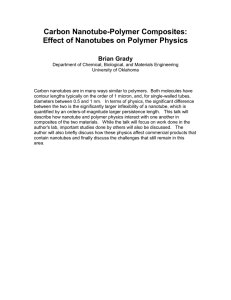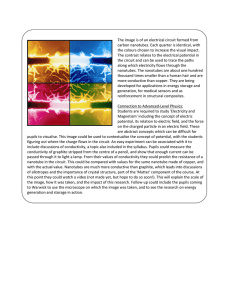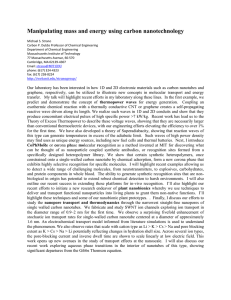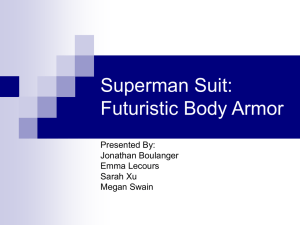International Journal of Application or Innovation in Engineering & Management...
advertisement
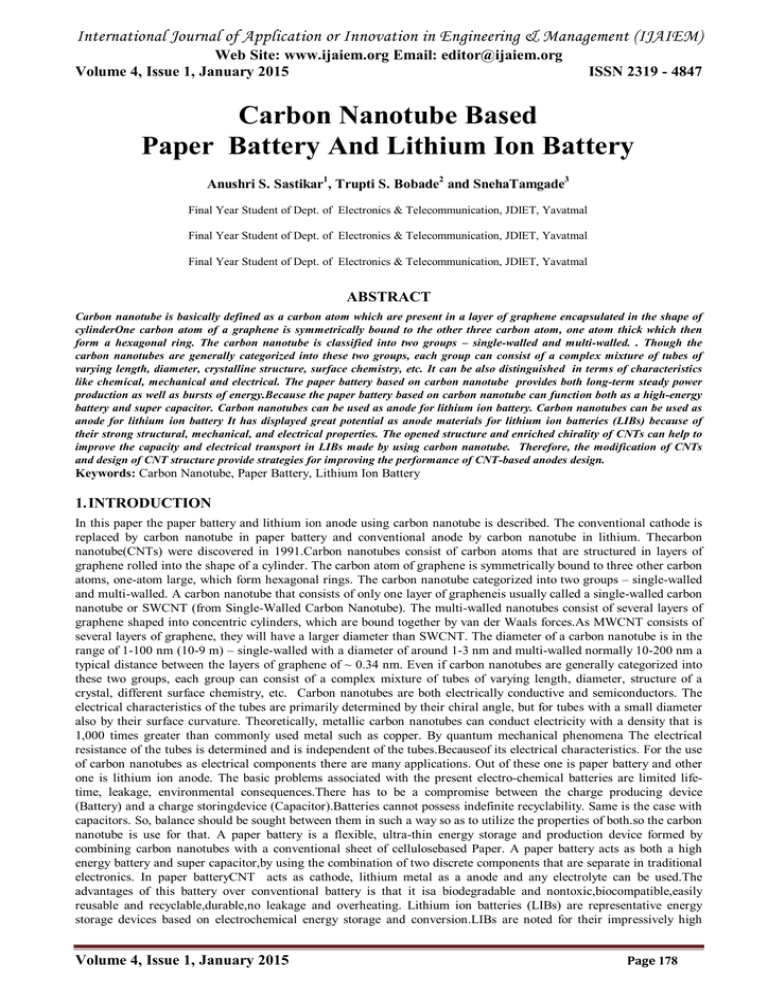
International Journal of Application or Innovation in Engineering & Management (IJAIEM) Web Site: www.ijaiem.org Email: editor@ijaiem.org Volume 4, Issue 1, January 2015 ISSN 2319 - 4847 Carbon Nanotube Based Paper Battery And Lithium Ion Battery Anushri S. Sastikar1, Trupti S. Bobade2 and SnehaTamgade3 Final Year Student of Dept. of Electronics & Telecommunication, JDIET, Yavatmal Final Year Student of Dept. of Electronics & Telecommunication, JDIET, Yavatmal Final Year Student of Dept. of Electronics & Telecommunication, JDIET, Yavatmal ABSTRACT Carbon nanotube is basically defined as a carbon atom which are present in a layer of graphene encapsulated in the shape of cylinderOne carbon atom of a graphene is symmetrically bound to the other three carbon atom, one atom thick which then form a hexagonal ring. The carbon nanotube is classified into two groups – single-walled and multi-walled. . Though the carbon nanotubes are generally categorized into these two groups, each group can consist of a complex mixture of tubes of varying length, diameter, crystalline structure, surface chemistry, etc. It can be also distinguished in terms of characteristics like chemical, mechanical and electrical. The paper battery based on carbon nanotube provides both long-term steady power production as well as bursts of energy.Because the paper battery based on carbon nanotube can function both as a high-energy battery and super capacitor. Carbon nanotubes can be used as anode for lithium ion battery. Carbon nanotubes can be used as anode for lithium ion battery It has displayed great potential as anode materials for lithium ion batteries (LIBs) because of their strong structural, mechanical, and electrical properties. The opened structure and enriched chirality of CNTs can help to improve the capacity and electrical transport in LIBs made by using carbon nanotube. Therefore, the modification of CNTs and design of CNT structure provide strategies for improving the performance of CNT-based anodes design. Keywords: Carbon Nanotube, Paper Battery, Lithium Ion Battery 1. INTRODUCTION In this paper the paper battery and lithium ion anode using carbon nanotube is described. The conventional cathode is replaced by carbon nanotube in paper battery and conventional anode by carbon nanotube in lithium. Thecarbon nanotube(CNTs) were discovered in 1991.Carbon nanotubes consist of carbon atoms that are structured in layers of graphene rolled into the shape of a cylinder. The carbon atom of graphene is symmetrically bound to three other carbon atoms, one-atom large, which form hexagonal rings. The carbon nanotube categorized into two groups – single-walled and multi-walled. A carbon nanotube that consists of only one layer of grapheneis usually called a single-walled carbon nanotube or SWCNT (from Single-Walled Carbon Nanotube). The multi-walled nanotubes consist of several layers of graphene shaped into concentric cylinders, which are bound together by van der Waals forces.As MWCNT consists of several layers of graphene, they will have a larger diameter than SWCNT. The diameter of a carbon nanotube is in the range of 1-100 nm (10-9 m) – single-walled with a diameter of around 1-3 nm and multi-walled normally 10-200 nm a typical distance between the layers of graphene of ~ 0.34 nm. Even if carbon nanotubes are generally categorized into these two groups, each group can consist of a complex mixture of tubes of varying length, diameter, structure of a crystal, different surface chemistry, etc. Carbon nanotubes are both electrically conductive and semiconductors. The electrical characteristics of the tubes are primarily determined by their chiral angle, but for tubes with a small diameter also by their surface curvature. Theoretically, metallic carbon nanotubes can conduct electricity with a density that is 1,000 times greater than commonly used metal such as copper. By quantum mechanical phenomena The electrical resistance of the tubes is determined and is independent of the tubes.Becauseof its electrical characteristics. For the use of carbon nanotubes as electrical components there are many applications. Out of these one is paper battery and other one is lithium ion anode. The basic problems associated with the present electro-chemical batteries are limited lifetime, leakage, environmental consequences.There has to be a compromise between the charge producing device (Battery) and a charge storingdevice (Capacitor).Batteries cannot possess indefinite recyclability. Same is the case with capacitors. So, balance should be sought between them in such a way so as to utilize the properties of both.so the carbon nanotube is use for that. A paper battery is a flexible, ultra-thin energy storage and production device formed by combining carbon nanotubes with a conventional sheet of cellulosebased Paper. A paper battery acts as both a high energy battery and super capacitor,by using the combination of two discrete components that are separate in traditional electronics. In paper batteryCNT acts as cathode, lithium metal as a anode and any electrolyte can be used.The advantages of this battery over conventional battery is that it isa biodegradable and nontoxic,biocompatible,easily reusable and recyclable,durable,no leakage and overheating. Lithium ion batteries (LIBs) are representative energy storage devices based on electrochemical energy storage and conversion.LIBs are noted for their impressively high Volume 4, Issue 1, January 2015 Page 178 International Journal of Application or Innovation in Engineering & Management (IJAIEM) Web Site: www.ijaiem.org Email: editor@ijaiem.org Volume 4, Issue 1, January 2015 ISSN 2319 - 4847 energy density and high open circuit voltage. Despite superior performance, there are many challenges in the design of LIBs, one of which is improving the capacity and cycle life of the anode materials. graphite has been commonly used as an anode material for LIBs due to its high electronic conductivity. However, the capacity of LIBs based on graphite as an anode material can be theoretically limited, since lithium ions can only combine with every second carbon hexagon in the graphite sheets. The intercalation of lithium into graphite involves one lithium atom per six carbon atoms,which represented as LiC6. 2.CARBON NANOTUBE Carbon nanotubes consist of carbon atoms that are structured in layers of graphene structured into the shape of a cylinder. One carbon atom of a graphene is symmetrically bound to the other three carbon atom, one atom thick which then form a hexagonal ring. (Figure 1).Carbon nanotubes can be open or closed at the ends. At an atomic level, graphene has the honeycomb structureshown in Fig.1, where the small circles denote the location of carbon atoms and the lines depict carbon–carbon bonds [7]. Lattice basis vectors are α1 and α2 , as shown in the figure, and the relative position vector R=mα1+na2 where m and n are integers. A carbon nanotube can be formed by overlapping the graphene sheet into a cylinder carbon nanotubes form naturally in, for example, the arc discharge of carbon electrodes and are notmade by literally rollinggraphene sheets into cylinders.Obviously, the cylinder can be formed by wrapping the sheetalong any preferred axis. If the cylinder axis is the ξ axis in ƞFig. 1, the resulting tube is called a zigzag CN. If the cylinder Axis is theƞ axis in Fig. 1; the resulting tube is called an armchairCN. If the cylinder axis is neither ξ nor the ƞ axis as shown, resulting nanotube is called a chiral CN. Thus, carbon nanotubescan be characterized by the dual index (ɱ ,ƞ), where (ɱ ,0) for zigzag CN,(ɱ ,ɱ )for armchair CNs, and (ɱ ,ƞ)0<ƞ≠ɱ , for chiral nanotubes.The resulting cross-sectional radius of a carbon nanotube is given by Where b = 0.142nmis the interatomic distance in graphene. Fig. 1 Graphene sheet showing coordinate system, lattice basis vectors, and position vector .circle denotes the positions of carbon atoms The carbon nanotube is customary to categorize into two groups – single-walled and multi-walled. A carbon nanotube that consists of only one layer of graphene is usually called a single-walled carbon nanotube or SWCNT (from SingleWalled Carbon nanotube). The multi-walled nanotubes consist of several layers of grapheneshaped into concentric cylinders, which are bound together by van der Waals forces. In this report we will to refer to multi-walled carbon nanotubes as MWCNT (from Multi-Walled Carbon nanotube). MWCNTwill have a larger diameter than SWCNT because consists of several layers of graphene The most extreme MWCNT can be made up of up to several hundred concentric cylinders with a typical distance between the layers of graphene of ~ 0.34 nm. Even if carbon nanotubes are generally categorized into these two groups, each group can consist of a complex . Typically, the diameter of a carbon nanotube is in the range of 1-100 nm (10-9 m) .The single-walled with a diameter of around 1-3 nm and multi-walled normally 10-200 nm. The diameter of the tubes depends on the method of production in which the diameter of the catalytic metal particles used plays a decisive role, particularly for single-walled tubes. Even if the length of carbon nanotubes have to vary, they are generally in the order of tens of micrometers. The longest carbon nanotube reported measured 18 cm and the shortest is the organic compound cycloparaphenylene, which was synthesized in early 2009 . The length of the tubes varies dependent on the manufacturing and purification process.,residues and impurities from Volume 4, Issue 1, January 2015 Page 179 International Journal of Application or Innovation in Engineering & Management (IJAIEM) Web Site: www.ijaiem.org Email: editor@ijaiem.org Volume 4, Issue 1, January 2015 ISSN 2319 - 4847 the manufacturing process are removed during the purification process; the nanotubes tend to be shorter due to the destructive conditions the tubes are subject to during purification mixture of tubes of varying length, diameter, crystalline structure, surface chemistry, etc. The atomic structure of carbon nanotubes is described by the tube’s chiral angle. The chiral angle determines how twisted the hexagons are in the graphene structure, as illustrated in Figure 1. Since the distance between the carbon atoms in the graphene structure is constant, tubes of different chiral angles will have different diameters. Multi-walled carbon nanotubes usually have adjacent chiral angles,concentricgraphene layers hence the varyingchiral angles. Fig 2. a-b) The atomic structure of single-walled carbon nanotubes for two types of tubes: (a) shows a so-called ―armchair‖ structure and (b) a zigzag structure. c) A diagram of different ―twists‖ and chiral angles of a graphene sheet The chiral angle of carbon nanotubes affects some of their properties such as mechanical properties, optical properties and, in particular, their electrical properties. Graphene itself is a semiconductor. Nanotubes in contrast, can be both metallic or semiconductors depending on the chiral angle. The mechanical properties are only affected minimally by the chiral angle. 1.Properties of carbon nanotube: It is very rare that SWCNT are found as individual tubes; they are more often arranged in large bundles, 5-50 nm in diameter which are held together by van der Waals forces. These bundles in turn form themselves into larger agglomerates or clumps. MWCNT (multi-walled carbon nanotubes) appear more as individual tubes, but even these tend to form bundles. The cohesive van der Waals forces are however weaker for MWCNT than for SWCNT .Due to their structure, carbon nanotubes have a very high surface area compared to their mass. The ratio of surface area and mass of the tubes depends on their diameter and the degree to which they form bundles. A single SWCNT have a ratio(surface area to mass) of about 1300 m2/g, while ratio of around a few 100 m2/g is of MWCNT. Because SWCNT form themselves into bundles, the effective ratio of surface area and mass is often smaller or around ~ 300 m2/g. Physical properties One of the carbon nanotubes’ coveted properties is that they have extreme strength. Single-walled carbon nanotubes are said to be around 10 times stronger than steel and 1-2 times stiffer (axial) than diamond and are considered to be one of the stiffest materials. Its excellent mechanical propertiesis because of the the strong covalent bonds (sp² hybrids) that connect the carbon atoms in the graphene structure. A nanotubes are relatively soft and easily deformed radially. A study has shown that the van der Waals forces from adjacent carbon nanotubes are sufficient to deform the tubes. They are very flexible (radial flexibility) and can be bent several times up to 90 degrees without being damaged. Chemical Properties Thedegree and type of impurities depends on the production and purification method. Generally speaking, vapour phase methods tend to generate carbon nanotubes with smaller amounts of impurities and are also considered to be easier to scale up. carbon nanotubes indicate a purity of >95% (mass), whereas for other commercial products, a degree of purity of >60% and up to >99% is indicated. In toxicological studies, the effect of impurities in the bulk samples used should be considered when certain impurities in such low quantities as 1% may in fact be toxic. Electrical Properties Carbon nanotubes are electrically conductive and semiconductors. The chiral angle determined characteristics of the tubes are primarily ,but for tubes with a small diameter also by their surface curvature. Theoretically, metallic carbon nanotubes can conduct electricity with a density that is 1,000 times greater than metals such as copper. The electrical resistance of the tubes is determined by quantum mechanical phenomena and is independent of the tubes’ length. There are many applications for the use of carbon nanotubes as electrical components. For example, diodes could be produced by merging SWCNT that have different electrical properties. It has also been shown that the electrical Volume 4, Issue 1, January 2015 Page 180 International Journal of Application or Innovation in Engineering & Management (IJAIEM) Web Site: www.ijaiem.org Email: editor@ijaiem.org Volume 4, Issue 1, January 2015 ISSN 2319 - 4847 properties of the tubes change during deformation and stretching. This further increases the potential for the use of carbon nanotubes in electromechanical components such as sensors. Due to its electrical property it is widely use in paper battery and use as anode in lithium ion battery anode. 2.1 Paper Battery: There has to be a compromise between the charge producing device (Battery) and a charge storing device(Capacitor). Batteries (whether primary or secondary) cannot possess indefinite recyclability.For the capacitors the case is same So, if a balance is carried out between them in such a way so as to utilize the properties of both, the results would be more efficient[12]. Owing to this fact and to the efficient properties of the Carbon nanotubes, there has been a steady and progressive interest in the global scientific community for its utilization in the production of Paper Batteries. A paper battery is a flexible, ultra-thin energy storage and production device formed by combining carbon nanotubes with a conventional sheet of cellulosebased paper. A paper battery acts as both a highenergy battery and super capacitor, combining two discrete components that are separate in traditional electronics. Cellulose is a complex organic substance found in paper and pulp; not digestible by humans. A carbon nanotubesis a very tiny cylinder formed from a single sheet of carbon atoms rolled into a tiny cylinder. These are stronger than steel and more conducting than the best semiconductors. They can be Single-walled or Multi-walled[4]. 2.1.1 Properties of Paper Batteries: The properties of Paper Batteries are mainly dependant to the properties of its constituents. a)Properties of Cellulose • It has a very high tensile strength and low shear strength. • It is biodegradable. • It is biocompatible. • It has a great porosity & absorption capacity. • It is easily reusable and recyclable • It is non –toxic b) Properties of Carbon Nanotube • It has a ratio of Width: Length = 1: . • It has a high tensile Strength (Greater than Steel). • It is very light and very flexible. • It has very good electrical conductivity (better than silicon). • It has low resistance (~33 ohm per sq. inch). • Its Output Open Circuit Voltage(O.C.V): 1.5-2.5 V. • The open circuit voltage of Paper Batteries is directly proportional to CNT concentration. • Stacking the Paper and CNT layers multiplies the Output Voltage; Slicing the Paper and CNT layers divides the Output Voltage. • Its thickness: typically about 0.5-0.7mm. • Its nominal continuous current density: 0.1 mA/cm2/ active area. • Temperature operating range: -75°C to +150°C. C) Additional Properties acquired by Paper Batteries: • Its Output Open Circuit Voltage(O.C.V): 1.5-2.5 V. • The O.C.V. of Paper Batteries is directly proportional to CNT concentration. • Stacking the Paper and CNT layers multiplies the Output Voltage. i.e.For length, l = V volts Slicing the Paper and CNT layers divides the Output Voltage i.e.For length,(l/2) =(V/2) volts fig 3.Variation of O.C.V . with stacking Volume 4, Issue 1, January 2015 Page 181 International Journal of Application or Innovation in Engineering & Management (IJAIEM) Web Site: www.ijaiem.org Email: editor@ijaiem.org Volume 4, Issue 1, January 2015 ISSN 2319 - 4847 3.2.1 Construction And Working For the construction of Paper Battery following comonents are required. • Carbon Nanotube (CNT) is used as Cathode. • Lithium metal (Li+) is used as a Anode. • All electrolytes including bioelectrolytes like blood, sweat and urine etc. are used. • Paper i.e. Cellulose is used as a seperator. fig. 4 Schematic of Paper Battery The process of construction is as follows Firstly, a common Xerox paper of desired shape and size is taken.Then, by conformal coating using a simple Mayer rod method[12]. The specially formulated ink with suitable substrates which is known as CNT ink is spread over the paper sample. The strong capillary force in paper enables high contacting surface area between thepaper and nanotubes after the solvent is absorbed and dried out in an oven. A thin lithium film is laminated over the exposed cellulose surface which completes paper battery. This paper battery is then connected to the aluminium current collectors which connect it to the load. 2.1.3 Advantages Over Existing Batteries 1. Being cellulose based product it is easily recycle and reuse, even with the existing paper recycling techniques. 2. Durable: It has a shelf life of three years at room temperature. Sometimes it can operate within 150°C. 3. It can be recharged upto 300 times using almost all electrolytes, includingbio-salts such as sweat, urine and blood i.e. this is rechargable battery. 4. Owing to low resistance, it does not get overheated evenunder extreme conditions.Since there are noleaky fluids, so even under spontaneous oraccidental damage, there is no leakage problem[12] 5. It is very light weight & flexible. 6. It is easily moldable into desired shapes & sizes. 7. Output voltage is variable by varying CNT concentration and by stacking & slicing. 2.1.4 Application The paper batteries have following application in various field: 1. In Electronics • The weight of these devices can be significantly reduced by replacing the alkaline batteries with paper batteries, without compromising with the power requirement.So it is used in laptop batteries, mobile phones, handheld digital cameras[12]. • In lowdrain devices such as calculators, wrist watch. • In wireless communication devices like speakers, mouse,Bluetooth headsets etc.[12] 2. In Medical Sciences • In Pacemakers for the heart • In Cosmetics, Drug-delivery systems • In glucose meters,sugar meters, etc which are the biosensors,in this cases it is used. 3. In Automobiles and Aircrafts • In Hybrid Car batteries • Since it redces Refueling hence it is used in Long Air Flights • For Light weight guided missiles. Volume 4, Issue 1, January 2015 Page 182 International Journal of Application or Innovation in Engineering & Management (IJAIEM) Web Site: www.ijaiem.org Email: editor@ijaiem.org Volume 4, Issue 1, January 2015 ISSN 2319 - 4847 2.1.5 Limitation and Disadvantages: Following are some limitations and disadvantages oh paper battery because It would not be logical only to ponder over the miraculous properties and applications of paper batteries • They can be ‘torn’ easily because it has low shear strength • The Techniques and the devices used in the production of Carbon Nanotubes are very expensive and very less Efficient.These are arc discharge, Chemical Vapour Depositon . 3.2 Lithium Ion Battery LIBs typically consist of a negative electrode (anode), a positive electrode (cathode), and a conducting electrolyte, and store electrical energy in the two electrodes in the form of Li-intercalation compounds. During charging of the LIBs, lithium ions released from the cathode move through the electrolyte and are inserted into the anode. Upon discharging, lithium ions are extracted from the anode[8] and move back to the cathode. Electrons that complete the half reaction will move through an extra external wire.since electrolytes are not responsible for the conduction of free electrons. fig.5 Schematic of Lithium Ion Battery The intercalation of lithium into graphite involves one lithium atom per six carbon atoms, i.e., LiC6, leading to a limited specific capacity of 372 mAh/g and an observed capacity of 280–330 mAh/g, depending on the type of graphite used. Carbon nanotubes (CNTs), an allotrope of graphite, have been reported to show much improved lithium capacity compared to graphite, due to their unique structures and properties[7]. CNTs have been reported to display conductivities as high as 106 S·m−1 and 105 S·m−1 for single-walled carbon nanotubes (SWCNTs) and multi-walled carbon nanotubes (MWCNTs), respectively, and high tensile strength up to 60 GPa. Recently, many investigations have focused on CNT-based anodes for LIBs with varying success, depending on the treatments employed. .As a promising candidate for LIB anode materials, CNTs have been widely researched with regard to lithium ion intercalation, adsorption, and diffusion, both theoretically and experimentally [9]. A surface mechanism by which the naked surface of CNTs and carbon nanoparticles are able to store lithium species, through investigation of the electrochemical intercalation of lithium into raw end-closed CNTs. Since the CNTs examined were end-caped, and no extra treatments were employed, the lithium adsorbed can only be localized at the surface of CNTs. The intercalation and diffusion of lithium ions in a CNT bundle by ab initio molecular dynamics simulations. They found that lithium ions can penetrate quickly into CNTs, and into the interstitial spaces between neighbouringCNTs. In this work, a new approach for lithium intercalation and storage was observed, in that lithium ions could remain between two neighbouring CNTs. However, lithium ions that are located between three neighbouring CNTs have very strong adsorption potentials, which make it difficult to remove lithium ions from the bundles of nanotubes[5]. 2.2.1 CNTs Structural Description The electrical and thermal conductivities of CNTs are as high as 104 S m−1 and 6600 W/mk, respectively. The superior mechanical properties of CNTs, with a Young’s modulus and tensile strength of 1.2 TPa and 50–200 GPa, respectively, make CNTs one of the strongest and stiffest materials. The extraordinary properties and unique structure of both SWCNTs and MWCNTs make them promising materials for a variety of applications [26]. CNTs are especially interesting asone-dimensional hosts for the intercalation of Li, and are regarded as one of the most promisingcandidates for the anode materials of LIBs. SWCNTs as Anode for LIBs SWCNTs can be envisioned as a rolled-up graphene sheet with diameter ranging from 0.4 to 2 nm, and length up to 1.5 cm. They can be described by a lattice vector (m, n) and a chiral angle, which determine the diameters and chiralities of SWCNTs. Based on the different lattice vectors and chiral angles, CNTs show three chiralities: armchair, zigzag, and chiral. CNTs with (m, m) and (m, 0) types of lattice vectors are termed as “armchair” and “zigzag,” respectively, and are otherwise “chiral”. The chirality of SWCNTs is closely related to the metallic or semiconducting structure of SWCNTs. For an (m, n) nanotube, when the difference between m and n is a multiple of 3, it is metallic; otherwise, the CNT is semiconducting. Volume 4, Issue 1, January 2015 Page 183 International Journal of Application or Innovation in Engineering & Management (IJAIEM) Web Site: www.ijaiem.org Email: editor@ijaiem.org Volume 4, Issue 1, January 2015 ISSN 2319 - 4847 MWCNT as Anode for LIBs: MWCNTs, with concentric graphene layers spaced 0.34 nm apart, display diameters from 10 to 20 nm and lengths of hundreds of microns [26]. SWCNTs can be described conveniently by chirality vectors. In contrast, the prediction of electronic properties of MWCNTs, which contain multipl layers of graphene sheets that may have different chiralities, is more complicated. However, due to the multiple rolled layers, MWCNTs are able to insert Li ions in a way similar to graphite, making them a promising candidate as an anode material for LIBs. Except for theinterplanar spacing of graphiticsheets that allows for the intercalation/deintercalation of lithium ions, the hollow cores of MWCNTs are also available for lithium ion intercalation. Therefore, the unique structures of MWCNTs should result in a higher capacity than that of graphite. Much work has been done to verify the excellent electrochemical performance of MWCNT-based anode materials in LIBs applications. The extremely pure structural characteristic of the MWCNTs produced led to excellent reversibility and small hysteretic loss of the MWCNTs, though with a moderate chemical diffusion coefficient of lithium.The exfoliation of MWCNTs, which involves peeling off graphene layers during electrochemical insertion of lithium ions, is a unique phenomenon that happens to MWCNTs due to their uniquestructure.[5] This process increases the anode surface area and thus the formation of a solid-electrolyteinterface (SEI) layer, which leads to an increased irreversible capacity of the anode materials. The electrochemical properties of vertically aligned MWCNTs and that ofnon-aligned MWCNTs for comparison. The structure of the aligned MWCNTs provides more sites at which lithium can be adsorbed, and the intimate contact of the MWCNTs in the aligned structure helps to maintain electrical continuity to the current collector. Both of these help to improve the electrochemical performance of an MWCNT-based anode as a high lithium storage capacity of 980 mAh/g in the first cycle was obtained and stabilized at about 750 mAh/g after more than ten cycles, while for the non-aligned MWCNTs, the values reduced to 158 and 58 mAh/g, respectively [5]. The vertically aligned MWCNTs also displayed substantially greater rate capability than the nonaligned ones, which emphasizes the important role that structure order plays in electrode performance. Fig. 6 Lithium Ion Battery using CNT as a anode 2.2.2Advantages With high volume, any reasonable size can be produced economically because it has a flexible form factor. So manufacturers are not bound by standard cell formats. There is no memory so no periodic discharge is needed and it requires low maintanance. It is more resistant to overcharge and has a less chance for electrolyte leakage. 2.2.3 Application: It has following application in following electrical devices It used to improve off-grid renewable energy . It is used in electric vehicles. It is used in Vented Nickel Cadmium (NiCd) Aircraft Batteries. It is used in the formation of Ultracapacitors. Volume 4, Issue 1, January 2015 Page 184 International Journal of Application or Innovation in Engineering & Management (IJAIEM) Web Site: www.ijaiem.org Email: editor@ijaiem.org Volume 4, Issue 1, January 2015 ISSN 2319 - 4847 3.2.4 Limitations: Compared to lithium-ion it has lower energy density and decreased cycle count It is expensive to manufacture. It has no standard sizes. Most cells are produced for high volume consumer markets. It has a higher cost-to-energy ratio than lithium-ion. REFERANCES [1] Allen BL, Kichambare PD, Gou P, Vlasova II, Kapralov AA, Konduru N, Kagan VE & Star A (2008) “Biodegradation of Single-Walled Carbon Nanotubes through Enzymatic Catalysis.” [2] Yu Mf, Files Bs, Arepalli S &RuoffRs (2000) Tensile loading of ropes of single wall carbon nanotubes and their mechanical properties. [3] Per Gustavsson, Maria Hedmer, Jenny Rissler (2006).“Carbon nanotubesExposure, toxicology and protective measures.” [4] Pushparaj V. L, Manikoth S. M., Kumar A., Murugesan S., Ci L., Vajtai R., Linhardt R. J., Nalamasu O.,Ajayan P. M.(2002)"Flexible Nanocomposite Thin Film Energy Storage Devices". [5] Ng, S. H. W., J.; Guo, Z. P.; Chen, J.; Wang, G. X.;Liu, H. K. “Single Wall Carbon Nanotube Paper asAnode for Lithium-Ion Battery.” [6] Hu, L.; Hecht, D.; Gru¨ ner, G. “Carbon Nanotube ThinFilms: Fabrications, Properties, and Applications.” [7] Ando, Y.; Zhao, X.; Shimoyama, H.; Sakai, G.; Kaneto, K. “Physical properties of multiwalledcarbon nanotubes.” [8] De las Casas, C.; Li, W.-Z. “A review of application of carbon nanotubes for lithium ion batteryanode material.” [9] Welna, D.T.; Qu, L.; Taylor, B.E.; Dai, L.; Durstock, M.F.(2009)“Vertically aligned carbon nanotubeelectrodes for lithium-ion batteries.” [10] G. W. Hanson(2005), “Fundamental Transmission Properties of Carbon Nanotube”. [11] ZhiliXiong, Young Soo Yun and Hyoung-Joon Jin (2013), “Applications of Carbon Nanotubes for Lithium IonBattery Anode” [12] A. Ganguly1 , S. Sar ( 2011) ,“Paper battery- A promising Energy Solution For India.” Volume 4, Issue 1, January 2015 Page 185
